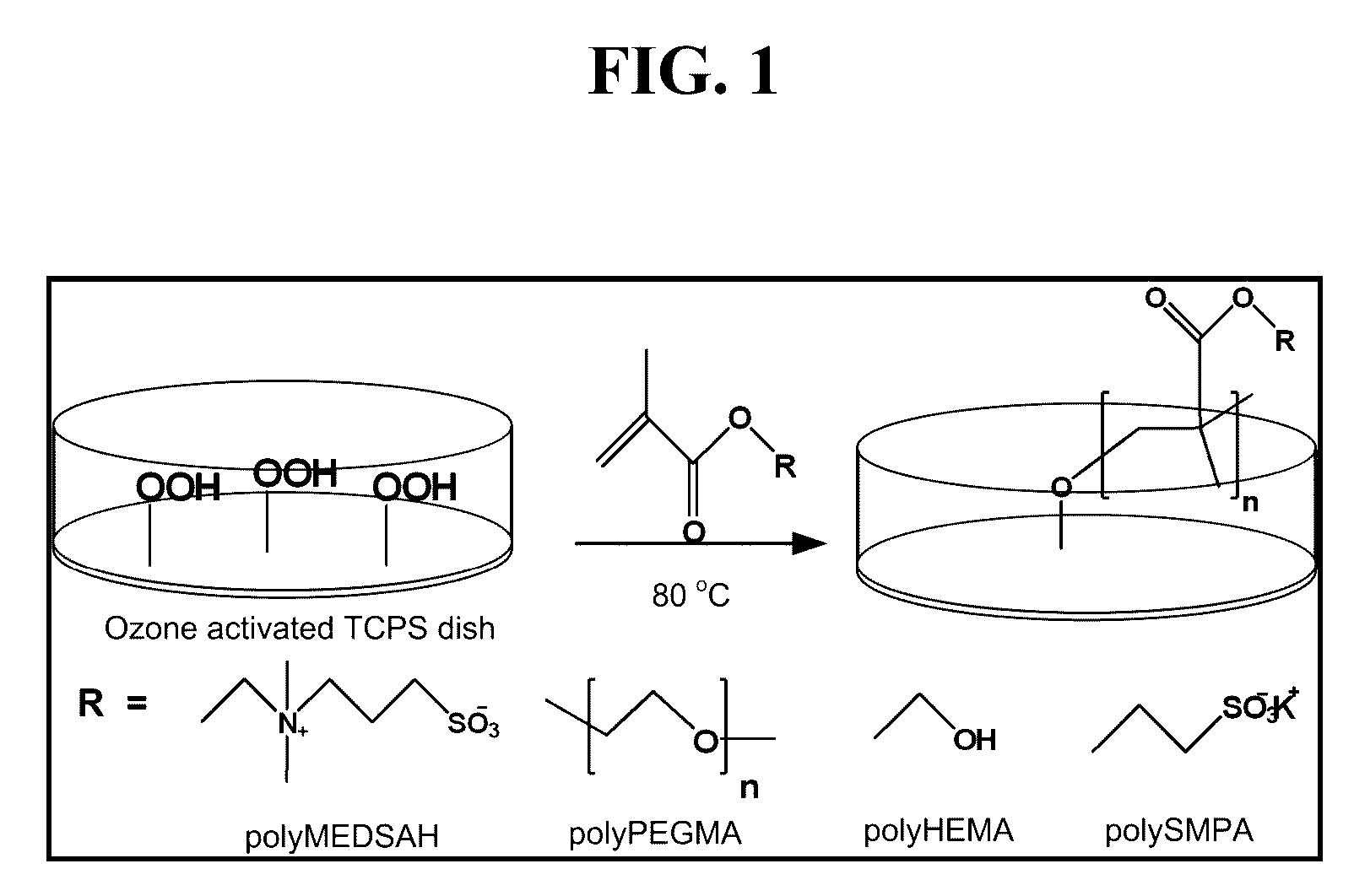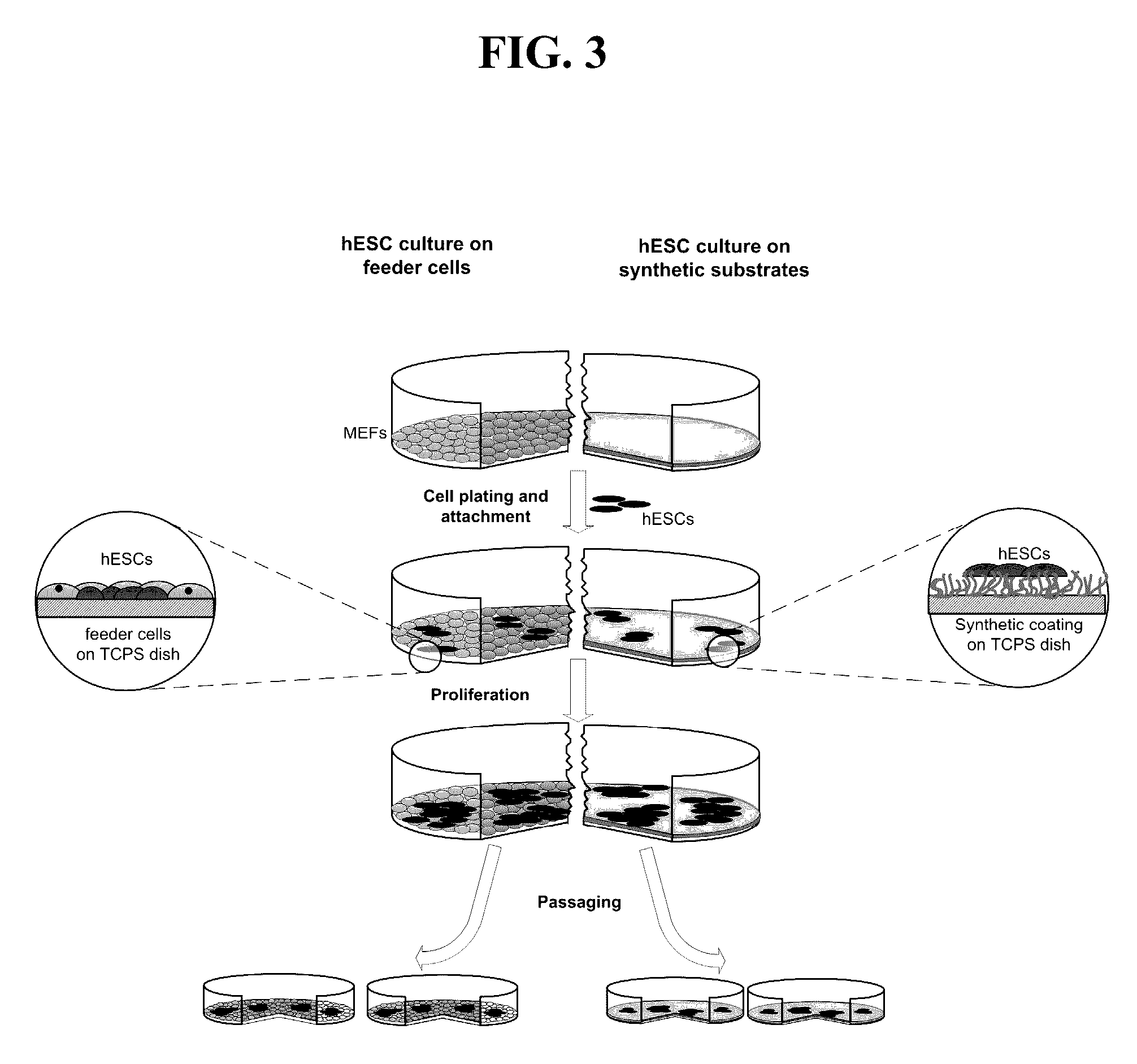Methods and compositions for growth of cells and embryonic tissue on a synthetic polymer matrix
a synthetic polymer matrix and cell technology, applied in the field of methods, can solve the problems of -batch inconsistencies, prone to contamination, and difficulty in establishing long-term hesc cultures, and achieve the effects of not yet established for long-term hesc cultures
- Summary
- Abstract
- Description
- Claims
- Application Information
AI Technical Summary
Benefits of technology
Problems solved by technology
Method used
Image
Examples
example 1
Human ESC Culture
[0077]The culture medium for hESCs growing on irradiated mouse embryonic fibroblast (MEF) cells consisted of DMEM / F12 supplemented with 20% knockout serum replacement, 0.1 mM β-mercaptoethanol, 1 mM L-glutamine, 1% nonessential amino acids and 4 ng / ml human recombinant basic fibroblast growth factor. To obtain MEF-conditioned media (MEF-CM), irradiated MEFs (8×106) were seeded on pre-gelled culture plate dishes. Twenty-four hours after plating, media was replaced for hESC culture media (60 ml), left in contact with MEFs to be conditioned for 24 h, and collected. Mouse embryonic fibroblasts were again fed with hESC culture media daily and used for 4 day CM collection. The CM was frozen at −20° C. until use, and before use it was supplemented with additional 0.1 mM β-mercaptoethanol, 2 mM L-glutamine, and 4 ng / ml bFGF. Passage of undifferentiated colonies was done manually cutting small clumps of cells. Criteria for passage was when greater than 50% of colonies reache...
example 2
Synthetic Substrate Characterization
[0080]Coating presences were confirmed using Fourier transformation infrared spectroscopy (FTIR), X-ray photoelectron spectroscopy (XPS), and imaging ellipsometry. Surface morphology of coatings was elucidated using scanning electron microscopy (SEM) and atomic force microscopy (AFM). Synthetic substrates plates were maintained at room temperature in desiccators and were exposed to UV-light for 15 min before using. Prior to cell seeding, all surfaces were washed twice with PBS, MEF-CM was added, and the plates were incubated at 37° C. in 5% CO2 overnight.
example 3
[0081]Immunostaining on cultured cells was performed to evaluate whether the synthetic substrates could maintain the hESCs in an undifferentiated state. For detecting OCT3 / 4, SOX-2, SSEA-4, TRA-1-60 and TRA-1-81, cells were fixed with 2% paraformaldehyde at room temperature for 15 min followed by permeabilization with 0.1% Triton X-100 for 10 min. All antibodies were detected with flourescein isothiocyanate (FITC)-labeled secondary antibody except for OCT3 / 4, which was detected with Texas Red-labeled secondary antibody. Cells were typically evaluation at the 5th, 10th and 15th passages. It was determined that the large majority of hESCs remained undifferentiated, with a low incidence (<5%) of spontaneous differentiation observed.
PUM
| Property | Measurement | Unit |
|---|---|---|
| thickness | aaaaa | aaaaa |
| thickness | aaaaa | aaaaa |
| thickness | aaaaa | aaaaa |
Abstract
Description
Claims
Application Information
 Login to View More
Login to View More - R&D
- Intellectual Property
- Life Sciences
- Materials
- Tech Scout
- Unparalleled Data Quality
- Higher Quality Content
- 60% Fewer Hallucinations
Browse by: Latest US Patents, China's latest patents, Technical Efficacy Thesaurus, Application Domain, Technology Topic, Popular Technical Reports.
© 2025 PatSnap. All rights reserved.Legal|Privacy policy|Modern Slavery Act Transparency Statement|Sitemap|About US| Contact US: help@patsnap.com



